Quality Assessment of PROBA-V LAI, fAPAR and fCOVER Collection 300 m Products of Copernicus Global Land Service
Abstract
:1. Introduction
- Assessment of the product spatiotemporal consistency with similar (CGLS PROBA-V Collection 1 km V1 and V2 and MODIS C6) satellite products;
- Assessment of the inter-annual and intra-annual precision of the product;
- Quantify product accuracy by comparisons with available in situ measurements collected mainly during the FP7 Imagines project.
2. Satellite-Derived LAI, fAPAR and fCOVER Products
2.1. Collection 300 m V1 PROBA-V LAI, fAPAR and fCOVER Products Under Evaluation
2.2. CGLS PROBA-V Collection 1 km
- V2 uses daily TOC reflectances and the associated cosine of the view zenith and sun zenith angles as inputs for the NNT, whereas V1 uses 10-day composite TOC reflectances;
- V2 applies temporal compositing over daily biophysical estimates by first removing outliers (e.g., mainly cloud mis-detection) by assuming a smooth temporal profile and then applying the CACAO method [26] (e.g., adjusting the magnitude and shift of the climatology) on a temporal window spanning a period between 30 and 60 days depending on the number of available observations, whereas V1 applies compositing at the TOC reflectance level by the inversion of a kernel-driven model over a temporal window [27];
- V2 delivers near-real-time estimates that are updated every 10 days until a consolidated value is reached after two months, whereas V1 products are delivered with a temporal delay of 20 days;
- V2 uses dedicated temporal smoothing and gap filling based on interannual climatology information [28] to ensure consistency and continuity (no missing data) of products, whereas V1 does not apply temporal smoothing or gap filling.
- The SWIR spectral band is not used since it is not available at a resolution of 300 m;
- No climatology is used as background information to fill gaps in the 300 m V1product, and gap filling is only applied over a local temporal window, which results in residual gaps for long periods of missing observations.
2.3. NASA MOD15A2H Collection 6
2.4. Quality Flags
3. Quality Assessment Methods and Ground Datasets
3.1. Ground Measurements
3.2. Validation Methods
3.2.1. Consistency Assessment with Similar Satellite Products
3.2.2. Precision Assessment
3.2.3. Accuracy Assessment with Ground Measurements
4. Quality Assessment Results
4.1. Consistency with Similar Products
4.1.1. Spatial Consistency
4.1.2. Temporal Consistency
4.1.3. Overall Spatiotemporal Consistency Between Products
4.2. Product Precision
4.2.1. Inter-Annual Precision
4.2.2. Intra-Annual Precision
4.3. Accuracy Assessment with Ground Measurements
4.3.1. Validation of PROBA-V Collection 300 m V1
4.3.2. Validation of MODIS and PROBA-V Products over the Common Samples
5. Discussion
6. Conclusions and Prospects
- Collection 300 m V1 shows overall good spatial consistency with respect to Collection 1 km products, with some discrepancies mainly observed over areas where the inputs are more likely to show large uncertainties. Low spatial consistency is found with respect to MODIS C6, mainly for fAPAR products.
- Collection 300 m V1 can be used to monitor the temporal evolution of vegetation with improved spatial resolution, good precision, a proper dynamic range (i.e., from 0 values for bare areas to maximum values for the densest canopies) and similar seasonal and inter-annual variations to reference products. Furthermore, it corrects some artefacts detected in PROBA-V Collection 1 km V1 for bare areas and northern latitudes.
- Collection 300 m V1 shows low overall discrepancies (RMSD) with respect to ground reference data with a slight positive bias for LAI and fAPAR while fCOVER displays large systematic deviations with ground measurements. All variables are overestimated over paddy rice fields, which has been observed for other satellite reference products, and similarly low performance is expected for flooded vegetated targets. The user should use the products with caution for applications related to such ecosystems.
Supplementary Materials
Author Contributions
Funding
Acknowledgments
Conflicts of Interest
Appendix A. LANDVAL Network of Sites

| Parameter | Threshold | Purpose |
|---|---|---|
| Distance to open water bodies [km] | 5 | Avoid open water bodies and their changing reflectance behaviour with viewing geometry |
| Minimum fraction of majority land cover type at 5 km distance | 60% | Avoid areas with heterogeneous land cover |
| Land Cover Majority at 5 km | Exclude “Water bodies” and “Urban areas” | |
| Vertical range [m] within a distance of 5 km | <300 m | Avoid areas with significant terrain variability close to a site. |
| Location (Latitude) | 60°S to 80°N | Exclude sites over extreme latitudes, where CGLS products do not provide data |
References
- Copernicus Global Land Service Site. Available online: https://land.copernicus.eu/global/ (accessed on 27 January 2020).
- GCOS#200. The Global Observing System for Climate: Implementation Needs. WMO, Geneva, Switzerland. Available online: https://gcos.wmo.int/en/gcos-implementation-plan (accessed on 8 October 2019).
- Chen, J.M.; Black, T.A. Foliage area and architecture of plants canopies from sunfleck size distributions. Agric. For. Meteorol. 1992, 60, 249–266. [Google Scholar] [CrossRef]
- Avissar, R.; Pielke, R.A. A Parameterization of heterogeneous Land Surfaces for Atmospheric Numerical Models and Its Impact on Regional Meteorology. Mon. Weather Rev. 1989, 117, 2113–2136. [Google Scholar] [CrossRef] [Green Version]
- Toté, C.; Swinnen, E.; Sterckx, S.; Clarijs, D.; Quang, C.; Maes, R. Evaluation of the SPOT/VEGETATION Collection 3 reprocessed dataset: Surface reflectances and NDVI. Remote Sens. Environ. 2017, 201, 219–233. [Google Scholar] [CrossRef]
- Dierckx, W.; Sterckx, S.; Benhadj, I.; Livens, S.; Duhoux, G.; Van Achteren, T.; Francois, M.; Mellab, K.; Saint, G. PROBA-V mission for global vegetation monitoring: Standard products and image quality. Int. J. Remote Sens. 2014, 35, 2589–2614. [Google Scholar] [CrossRef]
- ImagineS Website. Available online: http://fp7-imagines.eu/ (accessed on 27 January 2020).
- Baret, F.; Weiss, M.; Verger, A.; Smets, B. Atbd for Lai, Fapar and Fcover from Proba-V Products at 300 Mresolution (Geov3). Imagines_rp2.1_atbd-lai 300 m. Issue 1.73. Available online: https://land.copernicus.eu/global/sites/cgls.vito.be/files/products/ImagineS_RP2.1_ATBD-LAI300m_I1.73.pdf (accessed on 8 October 2019).
- Fernandes, R.; Plummer, S.; Nightingale, J.; Baret, F.; Camacho, F.; Fang, H.; Garrigues, S.; Gobron, N.; Lang, M.; Lacaze, R.; et al. Global Leaf Area Index Product Validation Good Practices. Version 2.0. In Best Practice for Satellite-Derived Land Product Validation (p.76): Land Product Validation Subgroup (WGCV/CEOS), Canada; 2014. Available online: https://lpvs.gsfc.nasa.gov/PDF/CEOS_LAI_PROTOCOL_Aug2014_v2.0.1.pdf (accessed on 3 February 2020). [CrossRef]
- Weiss, M.; Baret, F.; Block, T.; Koetz, B.; Burini, A.; Scholze, B.; Lecharpentier, P.; Brockmann, C.; Fernandes, R.; Plummer, S.; et al. On LineValidation Exercise (OLIVE): A web based service for the validation of medium resolution land products. Application to FAPAR products. Remote Sens. 2014, 6, 4190. [Google Scholar] [CrossRef] [Green Version]
- Camacho, F.; Baret, F.; Weiss, M.; Fernandes, R.; Berthelot, B.; Sánchez, J.; Latorre, C.; García-Haro, J.; Duca, R. Validación de algoritmos para la obtención de variables biofísicas con datos Sentinel2 en la ESA: Proyecto VALSE-2. In Proceedings of the XV Congreso de la Asociación Española de Teledetección (AET), Madrid, Spain, 22–24 October 2013. [Google Scholar]
- Garrigues, S.; Lacaze, R.; Baret, F.; Morisette, J.T.; Weiss, M.; Nickeson, J.E.; Fernandes, R.; Plummer, S.; Shabanov, N.V.; Myneni, R.B.; et al. Validation and intercomparison of global Leaf Area Index products derived from remote sensing data. J. Geophys. Res. Biogeosci. 2008, 113. [Google Scholar] [CrossRef]
- Weiss, M.; Baret, F.; Garrigues, S.; Lacaze, R. LAI and fAPAR CYCLOPES global products derived from VEGETATION. Part 2: Validation and comparison with MODIS collection 4 products. Remote Sens. Environ. 2007, 110, 317–331. [Google Scholar] [CrossRef]
- Morisette, J.T.; Baret, F.; Privette, J.L.; Myneni, R.B.; Nickeson, J.E.; Garrigues, S.; Shabanov, N.V.; Weiss, M.; Fernandes, R.A.; Leblanc, S.G.; et al. Validation of global moderate-resolution LAI products: A framework proposed within the CEOS land product validation subgroup. IEEE Trans. Geosci. RemoteSens. 2006, 44, 1804–1814. [Google Scholar] [CrossRef] [Green Version]
- Martínez, B.; García-Haro, F.J.; Camacho, F. Derivation of high-resolution leaf area index maps in support of validation activities: Application to the cropland Barrax site. Agric. For. Meteorol. 2009, 149, 130–145. [Google Scholar] [CrossRef]
- Camacho, F.; Latorre, C.; Lacaze, R.; Sanchez-Zapero, J.; Baret, F.; Weiss, M. Protocol for building a consistent database for accuracy assessment of LAI, fAPAR and fCover satellite products: The ImagineS database. Remote Sens. In preparation.
- Camacho, F.; Baret, F.; Lacaze, R. Guidelines for a Field Campaign. Available online: http://fp7-imagines.eu/pages/documents.php (accessed on 8 October 2019).
- Validation of Land European Remote Sensing Instruments (VALERI) Site. Available online: http://w3.avignon.inra.fr/valeri/ (accessed on 27 January 2020).
- Rahman, H.; Dedieu, G. SMAC: A Simplified Method for the Atmospheric Correction of satellite measurements in the solar spectrum. Int. J. Remote Sens. 1994, 16, 123–143. [Google Scholar] [CrossRef]
- Yang, W.; Huang, D.; Tan, B.; Stroeve, J.C.; Shabanov, N.V.; Knyazikhin, Y.; Nemani, R.R.; Myneni, R.B. Analysis of leaf area index and fraction of PAR absorbed by vegetation products from the terra MODIS sensor: 2000–2005. IEEE Trans. Geosci. Remote Sens. 2006, 44, 1829–1841. [Google Scholar] [CrossRef]
- Baret, F.; Hagolle, O.; Geiger, B.; Bicheron, P.; Miras, B.; Huc, M.; Berthelot, B.; Niño, F.; Weiss, M.; Samain, O.; et al. Lai, fapar and fcover cyclopes global products derived from vegetation Part 1: Principles of the algorithm. Remote Sens. Environ. 2007, 110, 275–286. [Google Scholar] [CrossRef] [Green Version]
- Smets, B.; Jacobs, T.; Verger, A. Leaf Area Index (LAI), Fraction of Photosynthetically Active Radiation (FAPAR), Fraction of Vegetation Cover (FCOVER) Collection 300 m Version 1. Product User Manual. Issue I1.60. Available online: https://land.copernicus.eu/global/sites/cgls.vito.be/files/products/GIOGL1_PUM_LAI300m-V1_I1.60.pdf (accessed on 8 October 2019).
- Sanchez-Zapero, J.; Fuster, B.; Camacho, F. Quality Assessment report LAI, FAPAR and FCOVER Collection 300 m V1. Issue I2.00. Copernicus Global Land Operations—Lot 1. Available online: https://land.copernicus.eu/global/sites/cgls.vito.be/files/products/CGLOPS1_QAR_LAI300-V1_I2.00.pdf (accessed on 8 October 2019).
- Baret, F.; Weiss, M.; Lacaze, R.; Camacho, F.; Makhmara, H.; Pacholcyzk, P.; Smets, B. GEOV1: LAI and FAPAR essential climate variables and FCOVER global time series capitalizing over existing products. Part1: Principles of development and production. Remote Sens. Environ. 2013, 137, 299–309. [Google Scholar]
- Verger, A.; Baret, F.; Weiss, M. Near real time vegetation monitoring at global scale. IEEE J. Sel. Top. Appl. Earth Obs. Remote Sens. 2014, 7, 3473–3481. [Google Scholar] [CrossRef]
- Verger, A.; Baret, F.; Weiss, M.; Kandasamy, S.; Vermote, E. The CACAO Method for Smoothing, Gap Filling, and Characterizing Seasonal Anomalies in Satellite Time Series. Geosci. Remote Sens. 2013, 51, 1963–1972. [Google Scholar] [CrossRef]
- Wanner, W.; Strahler, A.H.; Hu, B.; Lewis, P.; Muller, J.-P.; Li, X.; BarkerSchaaf, C.L.; Barnsley, M.J. Global retrieval of bidirectional reflectance and albedo over land from EOS MODIS and MISR data: Theory and algorithm. J. Geophys. Res. 1997, 102, 17143–17161. [Google Scholar] [CrossRef] [Green Version]
- Verger, A.; Baret, F.; Weiss, M.; Filella, I.; Peñuelas, J. GEOCLIM: A global climatology of lai, fapar, and fcover from vegetation observations for 1999–2010. Remote Sens. Environ. 2015, 166, 126–137. [Google Scholar] [CrossRef] [Green Version]
- Camacho, F.; Sánchez-Zapero, J.; Sánchez-Azofeifa, A.; Calvo-Rodriguez, S. Quality assessment report Proba-V Geov1 Lai, fapar, Fcover Issue i3.11. Gio-Gl lot 1. Available online: https://land.copernicus.eu/global/sites/cgls.vito.be/files/products/GIOGL1_QAR_LAI1km-V1_I3.11.pdf (accessed on 8 October 2019).
- Camacho, F.; Sánchez-Zapero, J.; Fuster, B. Quality Assessment Report LAI, FAPAR, FCOVER from PROBA-V Collection 1km Version 2. Issue I1.40. Copernicus Global Land Operations—Lot 1. Available online: https://land.copernicus.eu/global/sites/cgls.vito.be/files/products/CGLOPS1_QAR_LAI1km-PROBAV-V2_I1.40.pdf (accessed on 8 October 2019).
- Tan, B.; Hu, J.; Huang, D.; Yang, W.; Zhang, P.; Shabanov, N.; Knyazikhin, Y.; Nemani, R.; Myneni, R. Assessment of the broadleaf crops leaf area index product from the Terra MODIS instrument. Agric. For. Meteorol. 2005, 135, 124–134. [Google Scholar] [CrossRef]
- Knyazikhin, Y.; Martonchik, J.V.; Myneni, R.B.; Diner, D.J.; Running, S.W. Synergistic algorithm for estimating vegetation canopy leaf area index and fraction of absorbed photosynthetically active radiation from MODIS and MISR data. J. Geophys. Res. 1998, 103, 32257. [Google Scholar] [CrossRef] [Green Version]
- Vermote, E.; Vermeulen, A. Algorithm Technical Background Document. Atmospheric Correction Algorithm: Spectral Refelectances (MOD09), Version 4.0, 1999. Available online: https://lpdaac.usgs.gov/documents/305/MOD09_ATBD.pdf (accessed on 29 November 2019).
- Yan, K.; Park, T.; Yan, G.; Liu, Z.; Yang, B.; Chen, C.; Nemani, R.; Knyazikhin, Y.; Myneni, R. Evaluation of MODIS LAI/FPAR Product Collection 6. Part 2: Validation and Intercomparison. Remote Sens. 2016, 8, 460. [Google Scholar] [CrossRef] [Green Version]
- CAN-EYE Website. Available online: https://www6.paca.inra.fr/can-eye/ (accessed on 27 January 2020).
- CAN-EYE Output Variable. Definitions and Theoretical Background. Available online: https://www6.paca.inrae.fr/can-eye/content/download/3012/30459/version/4/file/Variables_Meaning_CAN_EYE.pdf (accessed on 27 January 2020).
- Lang, A.R.G.; Xiang, Y. Estimation of leaf area index from transmission of direct sunlight in discontinuous canopies. Agric. For. Meteorol. 1986, 37, 229–243. [Google Scholar] [CrossRef]
- Demarez, V.; Duthoit, S.; Baret, F.; Weiss, M.; Dedieu, G. Estimation of leaf area and clumping indexes of crops with hemispherical photographs. Agric. For. Meteorol. 2008, 48, 644–655. [Google Scholar] [CrossRef] [Green Version]
- Miller, J.B. A formula for average foliage density. Aust. J. Bot. 1967, 15, 141–144. [Google Scholar] [CrossRef]
- OLIVE Description. Available online: http://calvalportal.ceos.org/web/olive/descriptions (accessed on 27 January 2020).
- Latorre, C.; Piñó, M.C.; Camacho, F.; Kussul, N.; Skakun, S.; Kolotii, A.; Shelestov, A. Vegetation Field Data and Production of Ground-Based Maps: “Pshenichne Site, Ukraine” 12th June, 31st July 2014. Available online: https://search.datacite.org/works/10.13140/rg.2.1.1864.6165 (accessed on 8 October 2019).
- Piñó, M.C.; Latorre, C.; Camacho, F.; Kussul, N.; Skakun, S.; Kolotii, A.; Shelestov, A. Vegetation Field Data and Production of Ground-Based Maps: “Pshenichne Site, Ukraine” Multi-Temporal Campaign: April–July, 2015. Available online: https://www.researchgate.net/publication/303843859_Vegetation_Field_Data_and_Production_of_Ground-Based_Maps_Pshenichne_site_Ukraine_Multi-temporal_campaign_April_to_July_2015 (accessed on 8 October 2019).
- Latorre, C.; Camacho, F.; Zribi, M.; Ayari, H.; Mougenot, B.; Chahbi, A. Vegetation Field Data and Production of Ground-Based Maps: “Merguellil Site, Tunisia” January–May 2014. Available online: https://www.researchgate.net/publication/298791645_Vegetation_Field_Data_and_Production_of_Ground-Based_Maps_Merguellil_site_Tunisia_January_to_May_2014 (accessed on 8 October 2019).
- Latorre, C.; Camacho, F.; Pérez, M.; Beget, M.E.; Bella, C. Vegetation Field Data and Production of ground-Based Maps: “25 de Mayo site, La Pampa, Argentina” 7th–9th February 2014. Available online: https://www.researchgate.net/publication/280229289_Vegetation_Field_Data_and_Production_of_Ground-based_maps_25_DE_MAYO_SITE_LA_PAMPA_ARGENTINA_7th-_9th_February_2014 (accessed on 8 October 2019).
- Latorre, C.; Camacho, F.; Boschetti, M.; Busetto, L.; Nutini, F.; Fontanelli, G.; Ranghetti, L. Vegetation Field Data and Production of Ground-Based Maps: “Rosasco site, Pavia, Italy” 3rd July 2014. Available online: https://www.researchgate.net/publication/298790864_Vegetation_Field_Data_and_Production_of_Ground-Based_Maps_Rosasco_site_Pavia_Italy_3rd_July_2014 (accessed on 8 October 2019).
- Latorre, C.; Camacho, F.; González, M.P.; Muñoz, F.L. Vegetation Field Data and Production of Ground-Based Maps: “La Reina Site, Córdoba, Spain” 19th–20th May 2014. Available online: https://www.researchgate.net/publication/280078556_Vegetation_Field_data_and_production_of_ground-based_maps_LA_REINA_SITE_CORDOBA_SPAIN_19-_20_MAY_2014 (accessed on 8 October 2019).
- Latorre, C.; Camacho, F.; Cruz, F.; Atienzar, F. Vegetation Field Data and Production of Ground-Based Maps: “Las Tiesas—Barax site, Albacete, Spain” 29th–30th May 2014. Available online: https://www.researchgate.net/publication/282124254_Vegetation_field_data_and_production_of_ground-based_maps_LAS_TIESAS_-_BARRAX_SITE_ALBACETE_SPAIN_29th-_30th_May_2014 (accessed on 8 October 2019).
- Latorre, C.; Camacho, F.; Piñó, M.C.; Cruz, F. Vegetation Field Data and Production of Ground-Based Maps: “Las Tiesas—Barax Site, Albacete, Spain” 27th May and 22nd July 2015. Available online: https://www.researchgate.net/publication/298790723_Vegetation_Field_Data_and_Production_of_Ground-Based_Maps_Las_Tiesas-BARRAX_site_Albacete_Spain_27th_May_and_22nd_July_2015 (accessed on 8 October 2019).
- Camacho, F.; Vinué, D. Ground Data Processing & Production of High-Resolution Biophysical Maps: “Las Tiesas—Barax Site, Albacete, Spain” 6th May and 5th June 2016. Available online: https://www.researchgate.net/publication/340078415_Ground_Data_Processing_Production_of_High-Resolution_Biophysical_Maps_Las_Tiesas-Barax_Site_Albacete_Spain_6th_May_and_5th_June_2016(accessed on 8 October 2019).
- Sendra, V.; Latorre, C.; Camacho, F.; Sánchez, J.; García Haro, J.; Campos-Taberner, M.; Martínez, B. Vegetation Field Data and Production of Ground-Based Maps: “Albufera Site, Valencia, Spain” June–August 2014. Available online: https://www.researchgate.net/publication/304152122_Vegetation_Field_Data_and_Production_of_Ground-Based_Maps_Albufera_site_Valencia_-_Spain_June-August_2014 (accessed on 8 October 2019).
- Latorre, C.; Camacho, F.; Pattey, E. Vegetation Field Data and Production of Ground-Based Maps: “Ottawa Site, Canada” May to August 2014. Available online: https://www.researchgate.net/publication/298790768_Vegetation_Field_Data_and_Production_of_Ground-Based_Maps_Ottawa_site_Canada_May_to_August_2014 (accessed on 8 October 2019).
- Latorre, C.; Camacho, F.; Castrignanò, A.; Benedetto, D.; Stellacci, A.M.; Ventrella, D.; Campi, P.; Rinaldi, M.; Maddaluno, C.; Mucci, M.; et al. Vegetation Field Data and Production of Ground-Based Maps: “Capitanata Site, Italy” 18th March and 13th May, 2014. Available online: https://www.researchgate.net/publication/304151758_Vegetation_Field_Data_and_Production_of_Ground-Based_Maps_Capitanata_site_Italy_Multi-temporal_campaign_18th_March_and_13th_May_2014 (accessed on 8 October 2019).
- Latorre, C.; Camacho, F.; Mattar, C.; Santamaría-Artigas, A.; Leiva-Büchi, N. Vegetation Field Data and Production of Ground-Based Maps: “San Fernando Site, Chile” 19th January 2015. Available online: https://www.researchgate.net/publication/279852726_Vegetation_field_data_and_production_of_ground_based_maps_San_Fernando_site_Chile_19th_January_2015_i100 (accessed on 8 October 2019).
- Latorre, C.; Camacho, F.; Piñó, M.C.; Nestola, E.; Calfapietra, C.; Matteucci, G. Vegetation Field Data and Production of Ground-Based Maps: “Collelongo Site, Selvapiana, Italy” 8th July and 25th September 2015. Available online: https://www.researchgate.net/publication/303843874_Vegetation_Field_Data_and_Production_of_Ground-Based_Maps_Collelongo_site_-_Selvapiana_Italy_8th_July_and_25th_September_2015 (accessed on 8 October 2019).
- Camacho, F.; Latorre, C.; Cordingley, J.; Bossio, D.; Nganga, K.W.; Gicheha, J. Vegetation Field Data and Production of Ground-Based Maps: “Maragua Site (Upper Tana Basin), Kenya” 8th March 2016. Available online: https://www.researchgate.net/publication/304151992_Vegetation_Field_Data_and_Production_of_Ground-Based_Maps_Maragua_siteUpper_Tana_Basin_Kenya_8th_March_2016 (accessed on 8 October 2019).
- Camacho, F.; Vinué, D. Ground data Processing & Production of High-Resolution Biophysical Maps: “Liria Site, Spain” 9th February 2017. Available online: https://www.researchgate.net/publication/322952997_Ground_data_processing_production_of_high_resolution_biophysical_maps_Liria_Spain_9th_February_2017 (accessed on 8 October 2019).
- Fuster, B.; Camacho, F.; Vinué, D. Ground Data Processing & Production of High-Resolution Biophysical Maps: “Moncada Site, Spain” 22nd May, 18th July and 8th November 2017. Available online: https://www.researchgate.net/publication/324247280_Ground_data_processing_production_of_the_high_resolution_biophysical_maps_Moncada_site_-_Spain (accessed on 8 October 2019).
- Camacho, F.; Latorre, C.; Roujean, J.L. Vegetation Field Data and Production of Ground-Based Maps: “Ahspect Campaign, South-West, France” 22nd–25th June 2015. Available online: https://www.researchgate.net/publication/298723027_Vegetation_Field_data_and_Production_of_Ground-Based_Maps_AHSPECT_multi-site_campaign_South_West_France_22nd_-_25th_June_2015 (accessed on 8 October 2019).
- Li, W.; Baret, F.; Weiss, M.; Buis, S.; Lacaze, R.; Demarez, V.; Dejoux, J.; Battude, M.; Camacho, F. Combining hectometric and decametric satellite observations to provide near real time decametric FAPAR product. Remote Sens. Environ. 2017, 200, 250–262. [Google Scholar] [CrossRef]
- Mira, M.; Weiss, M.; Baret, F.; Courault, D.; Hagolle, O.; Gallego-Elvira, B.; Olioso, A. The MODIS (collection V006) BRDF/albedo product MCD43D: Temporal course evaluated over agricultural landscape. Remote Sens. Environ. 2015, 170, 216–228. [Google Scholar] [CrossRef] [Green Version]
- Nestola, E.; Sánchez-Zapero, J.; Latorre, C.; Mazzenga, F.; Matteucci, G.; Calfapietra, C.; Camacho, F. Validation of PROBA-V GEOV1 and MODIS C5 & C6 fAPAR Products in a Deciduous Beech Forest Site in Italy. Remote Sens. 2017, 9, 126. [Google Scholar] [CrossRef] [Green Version]
- Harper, W.V. Reduced Major Axis Regression: Teaching Alternatives to Least Squares. In Proceedings of the ICOTS 9 International Conference on the Teaching of Statistics, Flagstaff, AZ, USA, 13–18 July 2014; Available online: https://digitalcommons.otterbein.edu/math_fac/24 (accessed on 8 October 2019).
- GCOS-154. Systematic Observation Requirements for Satellite-Based Products for Climate Supplemental Details to the Satellite-Based Component of the Implementation Plan for the Global Observing System for Climate in Support of the UNFCCC–2011 Update; WMO: Geneva, Switzerland, 2011. [Google Scholar]
- Tao, X.; Shulnlin, L.; Wang, D. Assessment of five global satellite products of fraction of absorbed photosynthetically active radiation: Intercomparison and direct validation against ground-based data. Remote Sens. Environ. 2015, 163, 270–285. [Google Scholar] [CrossRef]
- D’Odorico, P.; Gonsamo, A.; Pinty, B.; Gobron, N.; Coops, N.; Mendez, E.; Schaepman, M.E. Intercomparison of fraction of absorbed photosynthetically active radiation products derived from satellite data over Europe. Remote Sens. Environ. 2014, 142, 141–154. [Google Scholar] [CrossRef]
- Martínez, B.; Camacho, F.; Verger, A.; García-Haro, F.J.; Gilabert, M.A. Intercomparison and quality assessment of MERIS, MODIS and SEVIRI FAPAR products over the Iberian Peninsula. Int. J. Appl. Earth Obs. Geoinf. 2013, 21, 463–476. [Google Scholar] [CrossRef]
- Geolocation Accuracy of PROBA-V. Available online: http://proba-v.vgt.vito.be/en/quality/platform-status-information/geolocation-accuracy (accessed on 27 January 2020).
- Campos-Taberner, M.; García-Haro, F.; Busetto, L.; Ranghetti, L.; Martínez, B.; Gilabert, M.A.; Camps-Valls, G.; Camacho, F.; Boschetti, M. A Critical Comparison of Remote Sensing Leaf Area Index Estimates over Rice-Cultivated Areas: From Sentinel-2 and Landsat-7/8 to MODIS, GEOV1 and EUMETSAT Polar System. Remote Sens. 2018, 10, 763. [Google Scholar] [CrossRef] [Green Version]
- Fang, H.; Zhang, Y.; Wei, S.; Li, W.; Ye, Y.; Sun, T.; Liu, W. Validation of global moderate resolution leaf area index (LAI) products over croplands in northeastern China. Remote Sens. Environ. 2019, 233, 111377. [Google Scholar] [CrossRef]
- Mu, X.; Huang, S.; Ren, H.; Yan, G.; Song, W.; Ruan, G. Validating GEOV1 Fractional Vegetation Cover Derived from Coarse-Resolution Remote Sensing Images Over Cropland. IEEE J. Sel. Top. Appl. Earth Obs. Remote Sens. 2015, 8, 439–446. [Google Scholar] [CrossRef]
- Fiducial Reference Measurement for Vegetation (FRM4Veg) Site. Available online: https://frm4veg.org/ (accessed on 27 January 2020).
- Ground-Based Observations for Validation (GBOV) of Copernicus Global Land Products Site. Available online: https://land.copernicus.eu/global/gbov (accessed on 27 January 2020).
- Loew, A.; Bennartz, R.; Fell, F.; Lattanzio, A.; Doutriaux-Boucher, M.; Schulz, J. A database of global reference sites to support validation of satellite surface albedo datasets (SAVS 1.0). Earth Syst. Sci. Data 2016, 8, 425–438. [Google Scholar] [CrossRef]
- Fell, F.; Bennartz, R.; Loew, A. Validation of the EUMETSAT Geostationary Surface Albedo Climate Data Record -2- (ALBEDOVAL-2). Available online: https://www.eumetsat.int/website/home/Data/TechnicalDocuments/index.html (accessed on 4 November 2019).

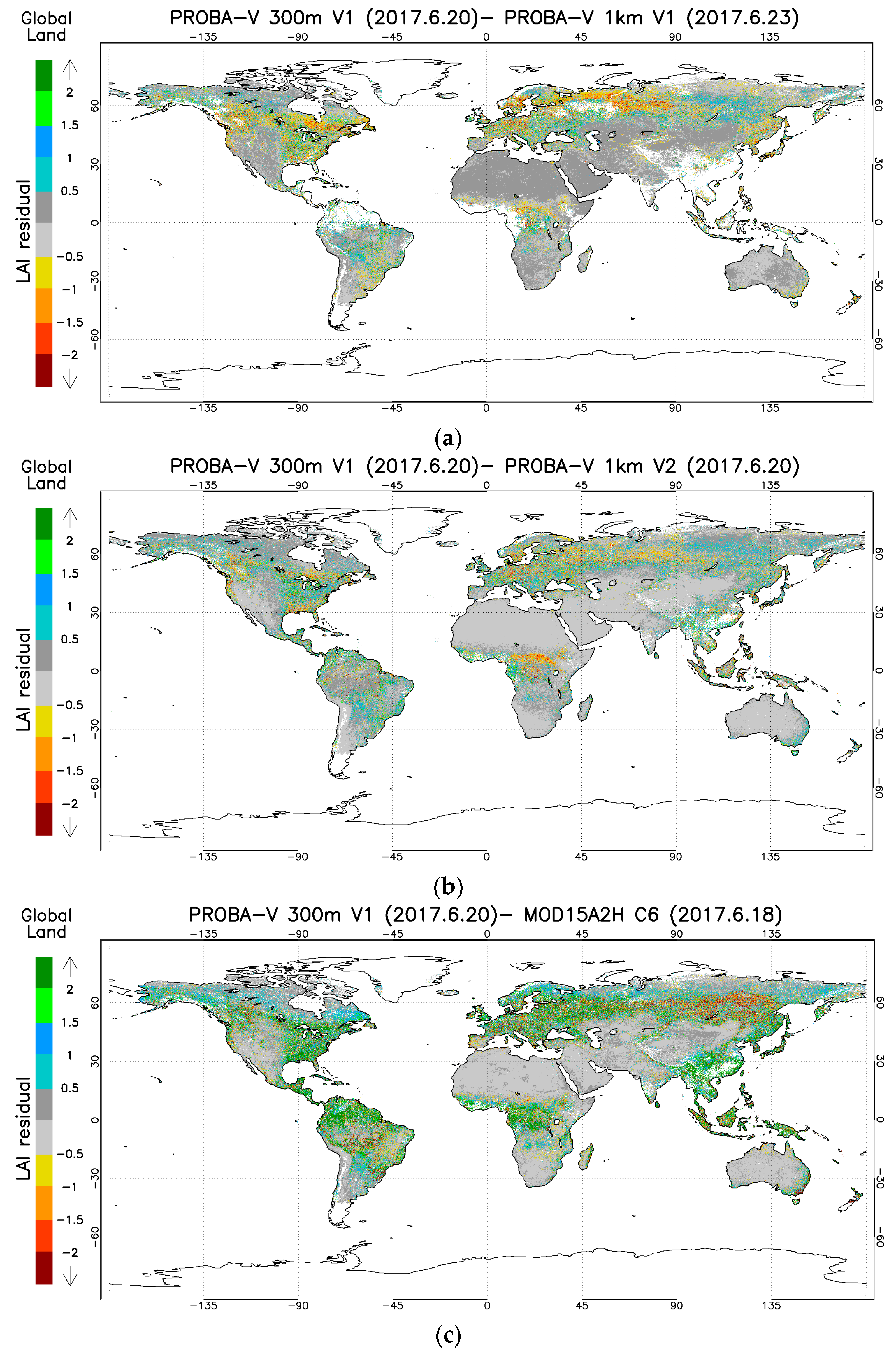
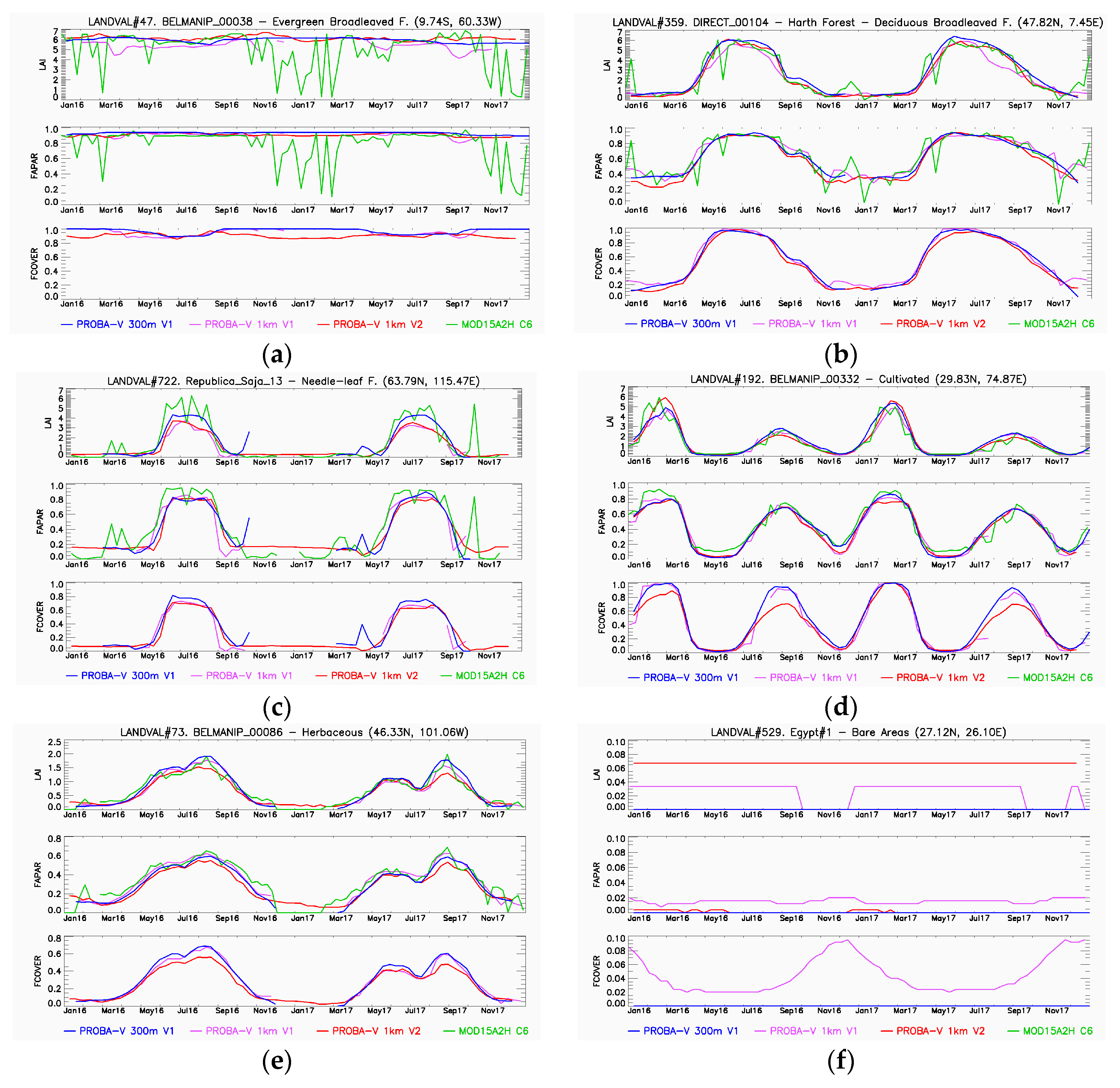



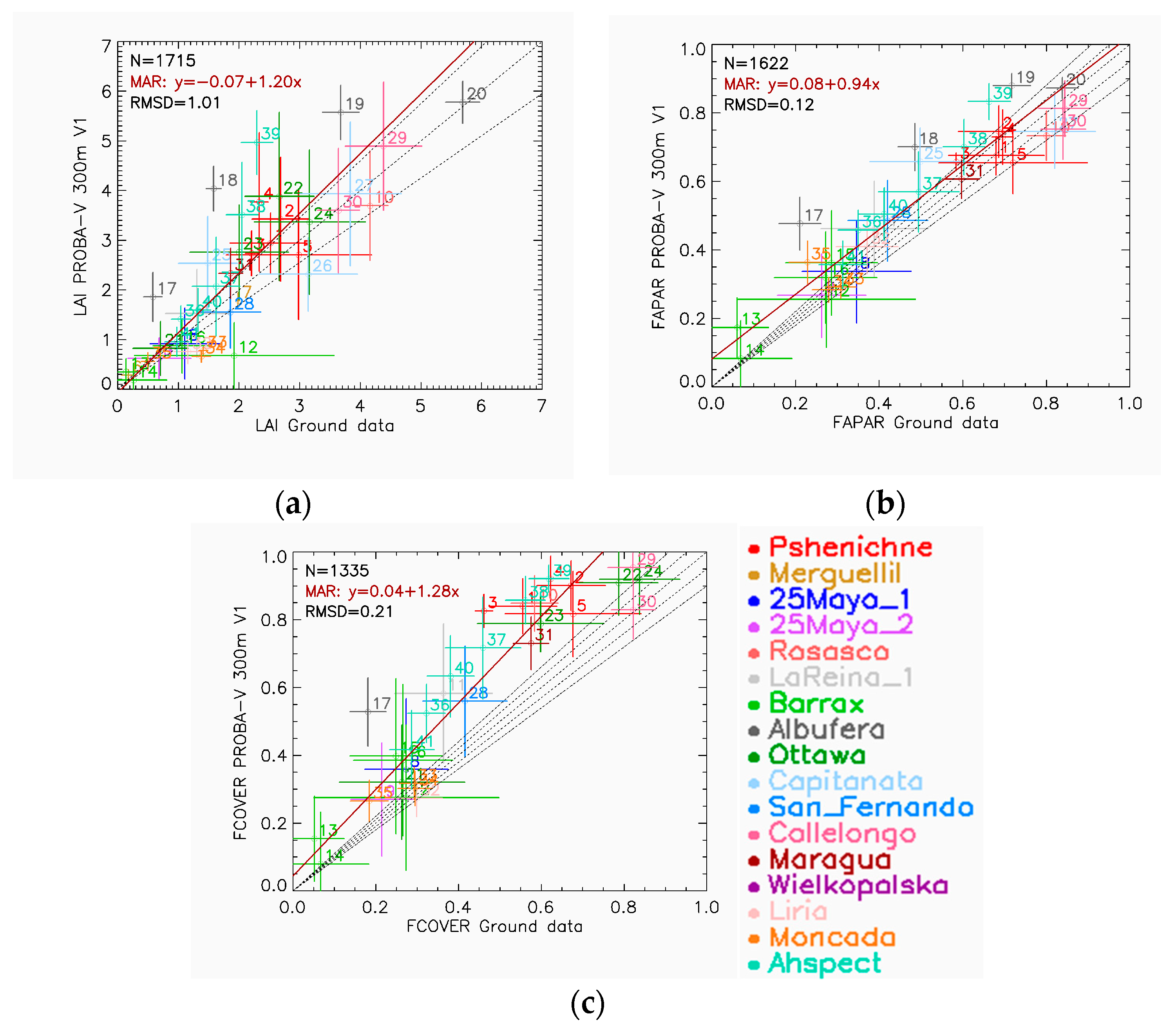
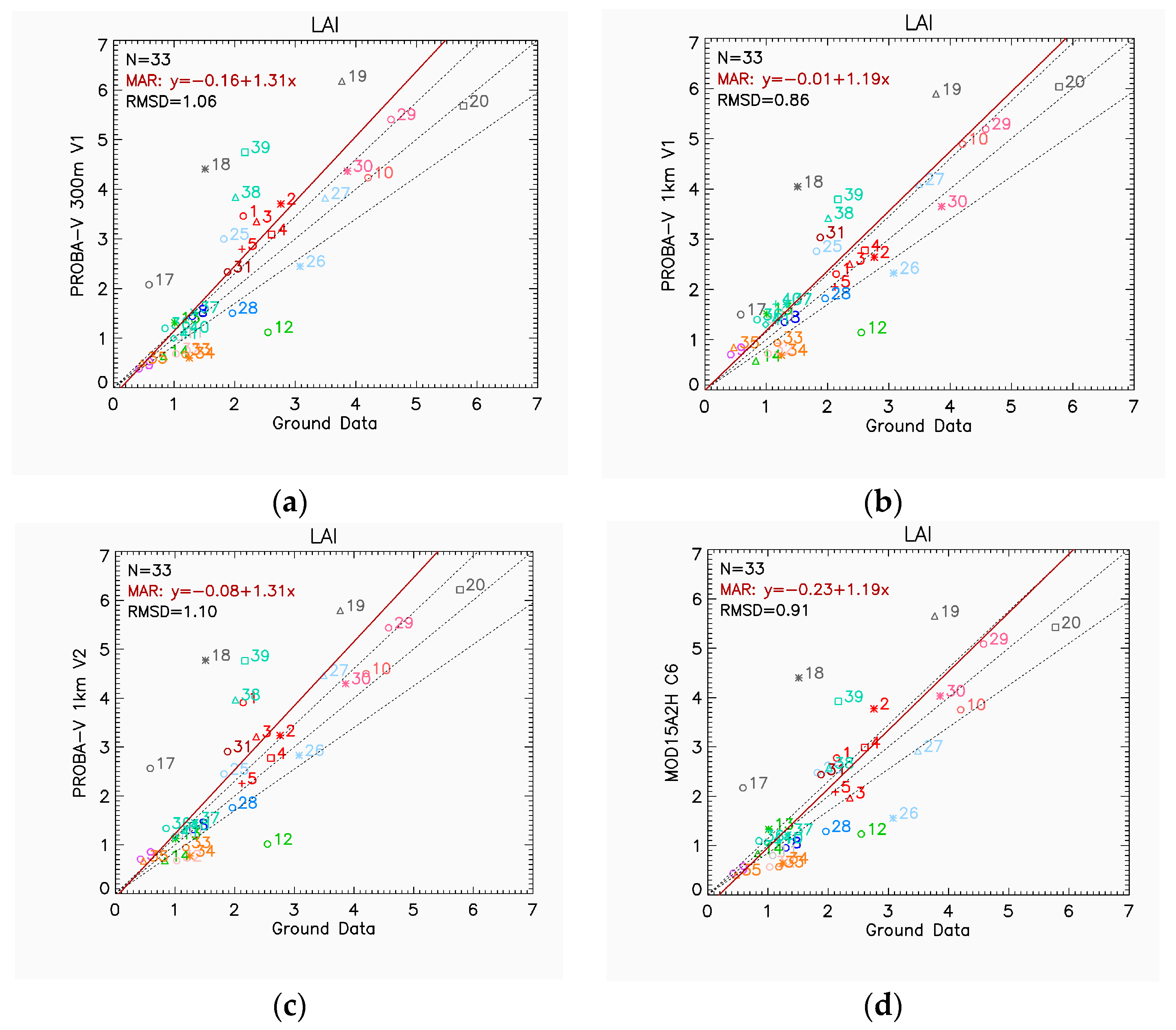
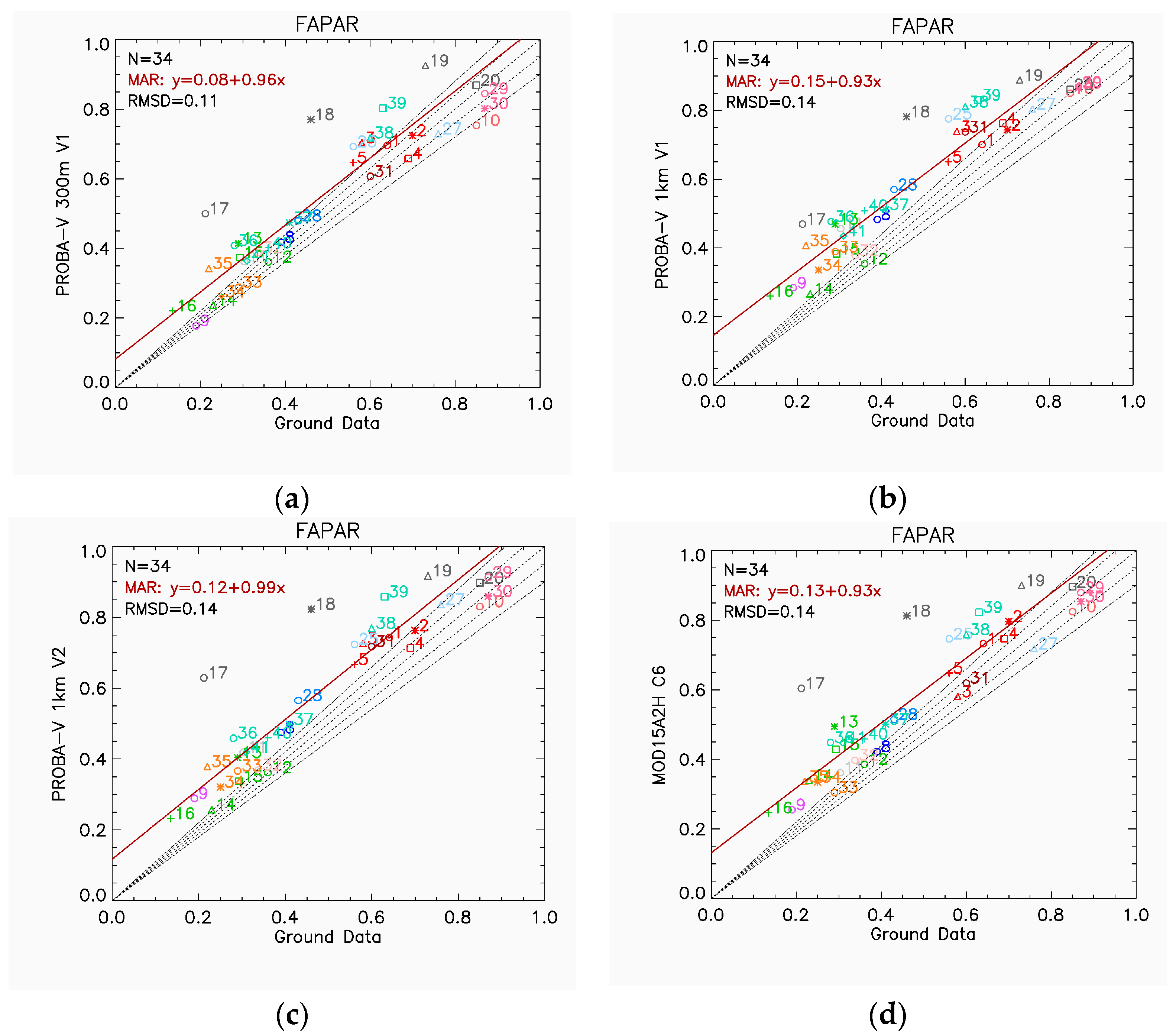
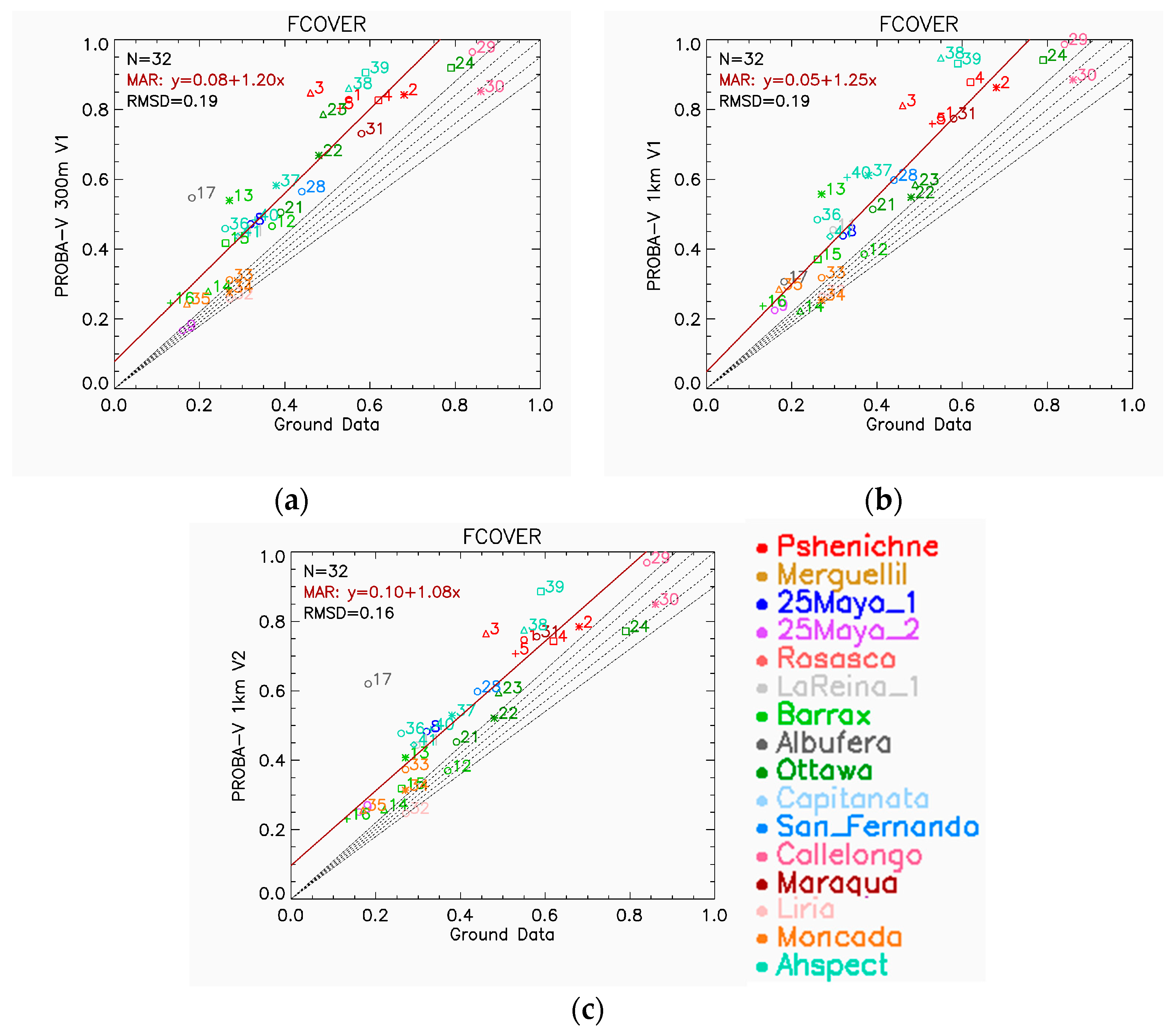
| Product | Quality Flag |
|---|---|
| PROBA-V Collection 1 km V1 | Sea (bit 1), Snow (bit 2), Input status out of range or invalid (bit 6), Output status out of range or invalid (bits 7,8,9), B2 saturated (bit 10), B3 saturated (bit 11). |
| PROBA-V Collection 1 km V2 | Sea (bit 1), Filled (bit 3), Input status out of range or invalid (bit 6), Output status out of range or invalid (bits 7,8,9). |
| MODIS C6 | Cloud state not clear (bit 4, 5 -FparLai), Main method failed or could not retrieve pixel value (bit 6, 7, 8 -FparLai). Shore, freshwater, ocean (bit 1, 2 - FparExtra), Cirrus detected (bit 5 - FparExtra) |
| Site | Country | Lat (deg) | Lon (deg) | Land Cover | Sample | Dates (mm/yyyy) | LAI | fAPAR | fCOVER | Reference |
|---|---|---|---|---|---|---|---|---|---|---|
| Pshenichne | Ukraine | 50.07 | 30.23 | Crops | #1 | 06/2014 | 2.14 | 0.64 | 0.55 | [41] |
| #2 | 07/2014 | 2.76 | 0.70 | 0.68 | ||||||
| #3 | 06/2015 | 2.36 | 0.58 | 0.46 | [42] | |||||
| #4 | 07/2015 | 2.61 | 0.69 | 0.62 | ||||||
| #5 | 07/2015 | 2.12 | 0.56 | 0.53 | ||||||
| Merguellil | Tunisia | 35.5662 | 9.9122 | Crops | #6 | 01/2014 | 0.18* | N/A | N/A | [43] |
| #7 | 04/2014 | 0.93* | N/A | N/A | ||||||
| 25Mayo_1 | Argentina | −37.9065 | −67.7459 | Crops | #8 | 02/2014 | 1.30 | 0.39 | 0.32 | [44] |
| 25Mayo_2 | Argentina | −37.9389 | −67.7890 | Shrub | #9 | 02/2014 | 0.42 | 0.19 | 0.16 | |
| Rosasco | Italy | 45.253 | 8.562 | Crops (Rice) | #10 | 07/2014 | 4.2 | 0.85 | N/A | [45] |
| LaReina | Spain | 37.8189 | −4.8624 | Crops | #11 | 05/2014 | 1.08 | 0.30 | 0.29 | [46] |
| Barrax | Spain | 39.0544 | −2.1007 | Crops | #12 | 05/2014 | 2.55 | 0.36 | 0.37 | [47] |
| #13 | 05/2015 | 1.01 | 0.29 | 0.27 | [48] | |||||
| #14 | 07/2015 | 0.83 | 0.23 | 0.22 | ||||||
| #15 | 03/2016 | N/A | 0.29 | 0.26 | [49] | |||||
| #16 | 07/2016 | 0.46* | 0.13 | 0.13 | ||||||
| Albufera | Spain | 39.2744 | −0.3164 | Crops (Rice) | #17 | 06/2014 | 0.58 | 0.21 | 0.18 | [50] |
| #18 | 06/2014 | 1.51 | 0.46 | N/A | ||||||
| #19 | 07/2014 | 3.77 | 0.73 | N/A | ||||||
| #20 | 08/2014 | 5.78 | 0.85 | N/A | ||||||
| Ottawa | Canada | 45.3056 | −75.7673 | Crops | #21 | 06/2014 | 1.03* | N/A | 0.39 | [51] |
| #22 | 06/2014 | 1.46* | N/A | 0.48 | ||||||
| #23 | 07/2014 | 1.82* | N/A | 0.49 | ||||||
| #24 | 07/2014 | 2.79* | N/A | 0.79 | ||||||
| Capitanata | Italy | 41.4637 | 15.4867 | Crops | #25 | 03/2014 | 1.82 | 0.56 | N/A | [52] |
| #26 | 05/2014 | 3.08 | N/A | N/A | ||||||
| #27 | 04/2015 | 3.49 | 0.76 | N/A | ||||||
| San Fernando | Chile | −34.7227 | −71.0019 | Crops | #28 | 01/2015 | 1.96 | 0.43 | 0.44 | [53] |
| Collelongo | Italy | 41.8500 | 13.5900 | DBF | #29 | 07/2015 | 4.58 | 0.87 | 0.84 | [54] |
| #30 | 09/2015 | 3.86 | 0.87 | 0.86 | ||||||
| Maragua | Kenya | −0.7720 | 36.9742 | Crops | #31 | 03/2016 | 1.88 | 0.60 | 0.59 | [55] |
| Liria | Spain | 39.7519 | −0.7005 | NLF | #32 | 02/2017 | 1.03 | 0.34 | 0.27 | [56] |
| Moncada | Spain | 39.5204 | −0.38697 | Crops | #33 | 05/2017 | 1.18 | 0.29 | 0.27 | [57] |
| #34 | 07/2017 | 1.25 | 0.25 | 0.27 | ||||||
| #35 | 11/2017 | 0.47 | 0.22 | 0.17 | ||||||
| Ahspect-MTO | France | 43.5728 | 1.3745 | Crops | #36 | 06/2015 | 0.85 | 0.28 | 0.26 | [58] |
| Ahspect-PEY | France | 43.6662 | 0.2195 | Crops | #37 | 06/2015 | 1.33 | 0.41 | 0.38 | |
| Ahspect-URG | France | 43.6397 | −0.4340 | Crops | #38 | 06/2015 | 2.01 | 0.60 | 0.55 | |
| Ahspect-CRE | France | 43.9936 | −0.0469 | Crops | #39 | 06/2015 | 2.17 | 0.63 | 0.59 | |
| Ahspect-CON | France | 43.9743 | 0.3360 | Crops | #40 | 06/2015 | 1.16 | 0.36 | 0.33 | |
| Ahspect-SAV | France | 43.8242 | 1.1749 | Crops | #41 | 06/2015 | 0.99 | 0.31 | 0.29 |
| Statistics | Interpretation |
|---|---|
| N: Number of samples | Indicative of the power of the validation. |
| RMSD: Root Mean Square Deviation | Overall Uncertainty. |
| B: Mean Bias | Difference between the average values of x and y. Indicative of accuracy. |
| S: Standard deviation | Standard deviation of the pair differences. Indicates precision. |
| R: Correlation coefficient | Indicates the strength of the relationship between two variables. The Pearson coefficient was used. |
| Major Axis Regression (slope, offset) | Indicates bias. |
| Uncertainty requirements (%) | Percentage of pixels meeting the CGLS or GCOS requirements. |
| p-value | Test to determine whether the slope is significantly different from 1 (p < 0.05). |
| Optimal | Target | Threshold | |
|---|---|---|---|
| LAI | 15%1 | Max (0.5, 20%) | Max (0.75, 25%) |
| fAPAR / fCOVER | 5% | Max (0.05, 10%)1 | Max (0.1, 20%) |
| LAI PROBA-V Collection 300 m V1 versus | PROBA-V Collection 1 km V1 | PROBA-V Collection 1 km V2 | MOD15A2H C6 |
|---|---|---|---|
| N | 26480 | 38770 | 33065 |
| Correlation (R) | 0.98 | 0.98 | 0.95 |
| Bias | 0.04 (3.4%) | −0.03 (2.5%) | 0.016 (1.3%) |
| RMSD | 0.36 (29.3%) | 0.31 (25.1%) | 0.53 (41.9%) |
| Intercept (MAR) | −0.05 | 0.01 | 0.01 |
| Slope (MAR) | 1.08 | 0.97 | 1.00 |
| p-value | <0.001 | <0.001 | 0.001 |
| fAPAR PROBA-V Collection 300 m V1 versus | PROBA-V Collection 1 km V1 | PROBA-V Collection 1 km V2 | MOD15A2H C6 |
|---|---|---|---|
| N | 26480 | 38528 | 33065 |
| Correlation (R) | 0.98 | 0.99 | 0.97 |
| Bias | −0.02 (6.6%) | −0.009 (2.7%) | −0.03 (9.5%) |
| RMSD | 0.06 (16.9%) | 0.04 (13.9%) | 0.08 (23.6%) |
| Intercept (MAR) | −0.01 | −0.01 | −0.04 |
| Slope (MAR) | 0.96 | 0.99 | 1.02 |
| p-value | <0.001 | 0.001 | <0.001 |
| fCOVER PROBA-V Collection 300 m V1 versus | PROBA-V Collection 1 km V1 | PROBA-V Collection 1 km V2 |
|---|---|---|
| N | 26457 | 37606 |
| Correlation (R) | 0.99 | 0.99 |
| Bias | <0.001 (0.1%) | 0.012 (4.0%) |
| RMSD | 0.05 (16.6%) | 0.05 (17.8%) |
| Intercept (MAR) | 0.00 | -0.01 |
| Slope (MAR) | 0.99 | 1.07 |
| p-value | 0.001 | <0.001 |
| PROBA-V Collection 300 m V1 | PROBA-V Collection 1 km V1 | PROBA-V Collection 1 km V2 | MOD15A2H C6 | |
|---|---|---|---|---|
| LAI | 0.070 (4.4%) | 0.081 (5.3%) | 0.048 (2.9%) | 0.102 (6.7%) |
| fAPAR | 0.018 (5.1%) | 0.018 (4.7%) | 0.011 (2.9%) | 0.025 (6.7%) |
| fCOVER | 0.017(4.8%) | 0.019 (5.3%) | 0.012 (3.5%) | - |
| LAI | fAPAR | fCOVER | |
|---|---|---|---|
| N | 1715 | 1622 | 1335 |
| Correlation (R) | 0.85 | 0.91 | 0.89 |
| Bias | 0.36 (15.5%) | 0.05 (10.3%) | 0.16 (32.2%) |
| RMSD | 1.01 (44.3%) | 0.12 (22.2%) | 0.21 (42.6%) |
| Intercept (MAR) | −0.07 | 0.08 | 0.04 |
| Slope (MAR) | 1.20 | 0.94 | 1.28 |
| p-value | <0.001 | 0.001 | <0.001 |
| LAI | fAPAR | fCOVER | |
|---|---|---|---|
| Optimal | 29.01 | 19.2 | 6.9 |
| Target | 58.1 | 35.71 | 13.3 |
| Threshold | 69.1 | 62.5 | 29.7 |
| Ground Data Versus | PROBA-V Collection 300 m V1 | PROBA-V Collection 1 km V1 | PROBA-V Collection 1 km V2 | MOD15A2H C6 |
|---|---|---|---|---|
| N | 33 | 33 | 33 | 33 |
| Correlation (R) | 0.82 | 0.86 | 0.82 | 0.81 |
| Bias | 0.5 (20.4%) | 0.4 (16.9%) | 0.6(23.7%) | 0.16 (7.5%) |
| RMSD | 1.06 (46.1%) | 0.86 (38.2%) | 1.10 (47.2%) | 0.91 (42.2%) |
| Intercept (MAR) | −0.16 | −0.01 | −0.08 | −0.23 |
| Slope (MAR) | 1.31 | 1.19 | 1.31 | 1.19 |
| p-value | 0.077 | 0.121 | 0.055 | 0.221 |
| Ground Data Versus | PROBA-V Collection 300 m V1 | PROBA-V Collection 1 km V1 | PROBA-V Collection 1 km V2 | MOD15A2H C6 |
|---|---|---|---|---|
| N | 34 | 34 | 34 | 34 |
| Correlation (R) | 0.92 | 0.93 | 0.91 | 0.91 |
| Bias | 0.06 (12.5%) | 0.11 (21.2%) | 0.11 (20.7%) | 0.10 (18.8%) |
| RMSD | 0.11 (21.3%) | 0.14 (25.8%) | 0.14 (26.8%) | 0.14 (25.8%) |
| Intercept (MAR) | 0.08 | 0.15 | 0.12 | 0.13 |
| Slope (MAR) | 0.96 | 0.93 | 0.99 | 0.93 |
| p-value | 0.587 | 0.250 | 0.816 | 0.247 |
| Ground Data Versus | PROBA-V Collection 300 m V1 | PROBA-V Collection 1 km V1 | PROBA-V Collection 1 km V2 |
|---|---|---|---|
| N | 32 | 32 | 32 |
| Correlation (R) | 0.90 | 0.91 | 0.89 |
| Bias | 0.16 (32.8%) | 0.16 (31.4%) | 0.13 (26.8%) |
| RMSD | 0.19 (39.0%) | 0.19(37.9%) | 0.16 (33.7%) |
| Intercept (MAR) | 0.08 | 0.05 | 0.10 |
| Slope (MAR) | 1.20 | 1.25 | 1.08 |
| p-value | 0.076 | 0.029 | 0.399 |
© 2020 by the authors. Licensee MDPI, Basel, Switzerland. This article is an open access article distributed under the terms and conditions of the Creative Commons Attribution (CC BY) license (http://creativecommons.org/licenses/by/4.0/).
Share and Cite
Fuster, B.; Sánchez-Zapero, J.; Camacho, F.; García-Santos, V.; Verger, A.; Lacaze, R.; Weiss, M.; Baret, F.; Smets, B. Quality Assessment of PROBA-V LAI, fAPAR and fCOVER Collection 300 m Products of Copernicus Global Land Service. Remote Sens. 2020, 12, 1017. https://0-doi-org.brum.beds.ac.uk/10.3390/rs12061017
Fuster B, Sánchez-Zapero J, Camacho F, García-Santos V, Verger A, Lacaze R, Weiss M, Baret F, Smets B. Quality Assessment of PROBA-V LAI, fAPAR and fCOVER Collection 300 m Products of Copernicus Global Land Service. Remote Sensing. 2020; 12(6):1017. https://0-doi-org.brum.beds.ac.uk/10.3390/rs12061017
Chicago/Turabian StyleFuster, Beatriz, Jorge Sánchez-Zapero, Fernando Camacho, Vicente García-Santos, Aleixandre Verger, Roselyne Lacaze, Marie Weiss, Frederic Baret, and Bruno Smets. 2020. "Quality Assessment of PROBA-V LAI, fAPAR and fCOVER Collection 300 m Products of Copernicus Global Land Service" Remote Sensing 12, no. 6: 1017. https://0-doi-org.brum.beds.ac.uk/10.3390/rs12061017







